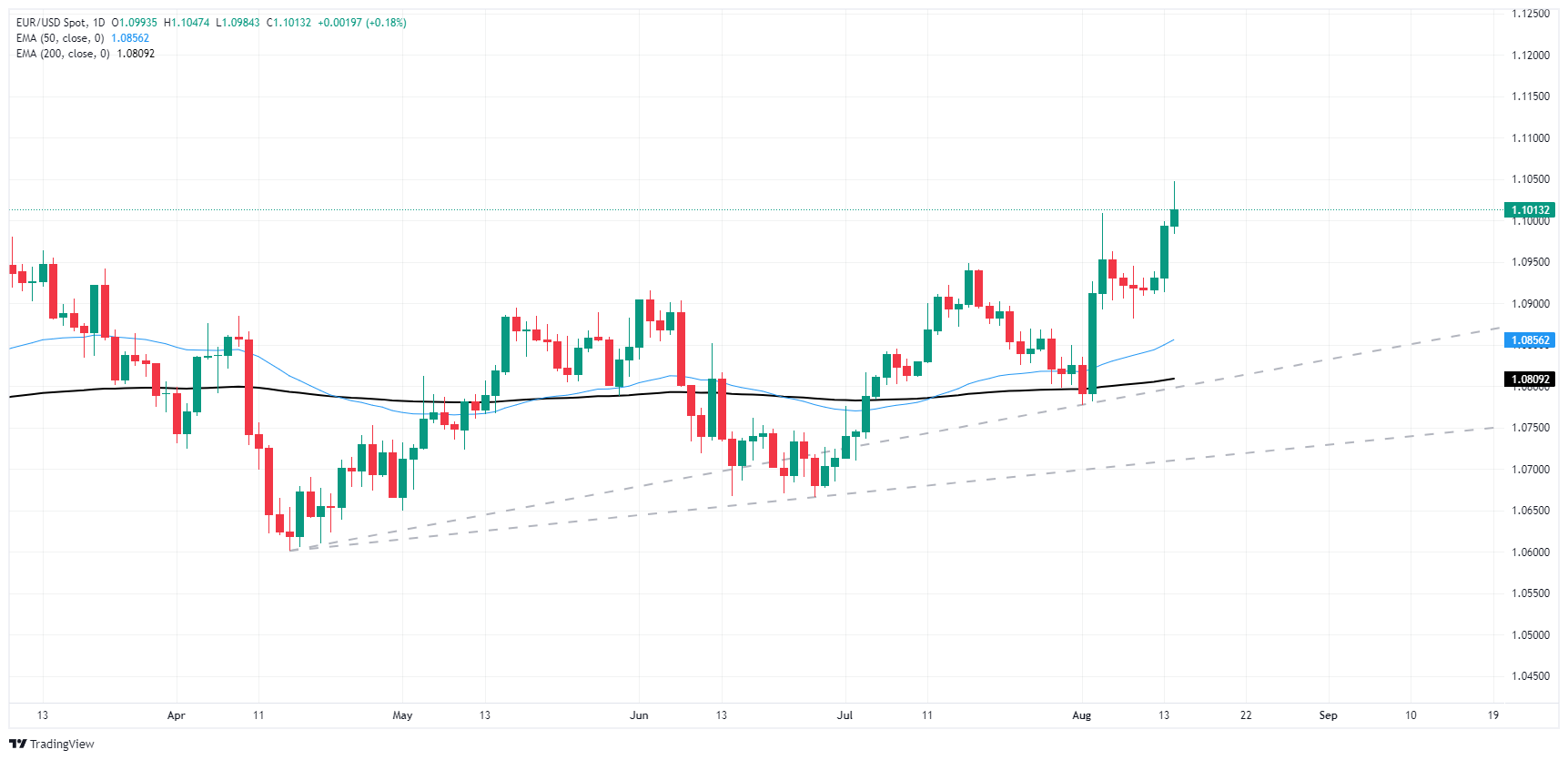- EUR/USD rose to a fresh seven-month high on Wednesday before falling back.
- EU GDP growth landed exactly where markets expected, and US CPI inflation cooled.
- US Retail Sales figures still in the barrel for Thursday.
EUR/USD caught a brief rally into a fresh seven-month peak bid before easing back toward the 1.1000 handle on Wednesday. Fiber caught a run over 1.1000 and into the 1.1050 level after pan-EU Gross Domestic Product (GDP) growth figure printed exactly as expected. Meanwhile, EU Industrial Production remains crimped and US Consumer Price Index (CPI) inflation figures met forecasts but still disappointed markets.
Forex Today: Soft or hard landing? Upcoming US data will have a say
Coming up on Thursday, US Retail Sales in July are expected to rebound to 0.3% after the previous month’s 0.0% flat hold. A fresh print of the University of Michigan’s Consumer Sentiment Index for August is also on the cards for later in the week, forecast to improve to 66.9 from 66.4.
Headline US CPI inflation printed at 2.9% YoY in July, slightly below the forecast hold at 3.0%, with core CPI inflation ticking down to 3.2% on an annualized basis from the previous 3.0% as markets had expected. Monthly CPI figures, both headline and core, rose 0.2% MoM in July, but even this figure was a round-up print from the data rates of 0.15% and 0.17% for headline and core CPI, respectively.
Despite easing consumer-level inflation figures, investors had been hoping for prints further below forecasts after this week’s US Producer Price Index (PPI) inflation showed steeper-than-expected drops in producer-level price pressures. However, easing price pressures don’t appear to be passing onto consumers on a one-to-one basis. According to the CME’s FedWatch Tool, rate markets are now pricing in only 40% odds of a double-cut from the Federal Reserve (Fed) on September 18, down from 50% earlier this week and 70% the week previous.
EUR/USD price forecast
EUR/USD chalked in a third straight gainer on Wednesday, mounting back over the 1.1000 handle and extending a near-term bullish tilt into a fresh seven-month peak near 1.1050. Bullish EUR/USD moves are threatening to run out of gas as the pair overextended too quickly from a technical rejection off of the 200-day Exponential Moving Average (EMA) at 1.0829.
EUR/USD daily chart
Euro FAQs
The Euro is the currency for the 20 European Union countries that belong to the Eurozone. It is the second most heavily traded currency in the world behind the US Dollar. In 2022, it accounted for 31% of all foreign exchange transactions, with an average daily turnover of over $2.2 trillion a day. EUR/USD is the most heavily traded currency pair in the world, accounting for an estimated 30% off all transactions, followed by EUR/JPY (4%), EUR/GBP (3%) and EUR/AUD (2%).
The European Central Bank (ECB) in Frankfurt, Germany, is the reserve bank for the Eurozone. The ECB sets interest rates and manages monetary policy. The ECB’s primary mandate is to maintain price stability, which means either controlling inflation or stimulating growth. Its primary tool is the raising or lowering of interest rates. Relatively high interest rates – or the expectation of higher rates – will usually benefit the Euro and vice versa. The ECB Governing Council makes monetary policy decisions at meetings held eight times a year. Decisions are made by heads of the Eurozone national banks and six permanent members, including the President of the ECB, Christine Lagarde.
Eurozone inflation data, measured by the Harmonized Index of Consumer Prices (HICP), is an important econometric for the Euro. If inflation rises more than expected, especially if above the ECB’s 2% target, it obliges the ECB to raise interest rates to bring it back under control. Relatively high interest rates compared to its counterparts will usually benefit the Euro, as it makes the region more attractive as a place for global investors to park their money.
Data releases gauge the health of the economy and can impact on the Euro. Indicators such as GDP, Manufacturing and Services PMIs, employment, and consumer sentiment surveys can all influence the direction of the single currency. A strong economy is good for the Euro. Not only does it attract more foreign investment but it may encourage the ECB to put up interest rates, which will directly strengthen the Euro. Otherwise, if economic data is weak, the Euro is likely to fall. Economic data for the four largest economies in the euro area (Germany, France, Italy and Spain) are especially significant, as they account for 75% of the Eurozone’s economy.
Another significant data release for the Euro is the Trade Balance. This indicator measures the difference between what a country earns from its exports and what it spends on imports over a given period. If a country produces highly sought after exports then its currency will gain in value purely from the extra demand created from foreign buyers seeking to purchase these goods. Therefore, a positive net Trade Balance strengthens a currency and vice versa for a negative balance.
Information on these pages contains forward-looking statements that involve risks and uncertainties. Markets and instruments profiled on this page are for informational purposes only and should not in any way come across as a recommendation to buy or sell in these assets. You should do your own thorough research before making any investment decisions. FXStreet does not in any way guarantee that this information is free from mistakes, errors, or material misstatements. It also does not guarantee that this information is of a timely nature. Investing in Open Markets involves a great deal of risk, including the loss of all or a portion of your investment, as well as emotional distress. All risks, losses and costs associated with investing, including total loss of principal, are your responsibility. The views and opinions expressed in this article are those of the authors and do not necessarily reflect the official policy or position of FXStreet nor its advertisers. The author will not be held responsible for information that is found at the end of links posted on this page.
If not otherwise explicitly mentioned in the body of the article, at the time of writing, the author has no position in any stock mentioned in this article and no business relationship with any company mentioned. The author has not received compensation for writing this article, other than from FXStreet.
FXStreet and the author do not provide personalized recommendations. The author makes no representations as to the accuracy, completeness, or suitability of this information. FXStreet and the author will not be liable for any errors, omissions or any losses, injuries or damages arising from this information and its display or use. Errors and omissions excepted.
The author and FXStreet are not registered investment advisors and nothing in this article is intended to be investment advice.
Recommended content
Editors’ Picks

AUD/USD holds below 0.6200 ahead of Trump’s inauguration
The AUD/USD pair weakens to around 0.6190, snapping the two-day losing streak during the early Asian session on Monday. The markets turn cautious as President-elect Donald Trump will be inaugurated later on Monday. The US market is closed on Monday due to the Martin Luther King Day bank holiday.

USD/JPY ticks lower on strong Machinery Orders data from Japan
USD/JPY attracts some intraday sellers following the release of upbeat Machinery Orders data from Japan and stalls its recovery from sub-155.00 levels, or a nearly four-week low touched on Friday. Furthermore, rising bets that the BoJ will hike rates against later this week contribute to capping the currency pair.

Gold attracts some sellers below $2,700, eyes on Trump's inauguration
Gold price extends its decline to near $2,695 during the early Asian session on Monday. The stronger US Dollar broadly ahead of President-elect Donald Trump’s inauguration exerts some selling pressure on the yellow metal.

Week ahead: Markets on edge as Trump’s inauguration and BoJ decision loom
Markets brace for impact ahead of Trump’s inauguration. BoJ seen raising rates at first gathering of 2025. Euro and Pound traders turn gaze to PMIs. Canada and New Zealand CPI data to shape BoC and RBNZ bets. World Economic Forum in Davos also in focus.

Five keys to trading Trump 2.0 with Gold, Stocks and the US Dollar Premium
Donald Trump returns to the White House, which impacts the trading environment. An immediate impact on market reaction functions, tariff talk and regulation will be seen. Tax cuts and the fate of the Federal Reserve will be in the background.

Trusted Broker Reviews for Smarter Trading
VERIFIED Discover in-depth reviews of reliable brokers. Compare features like spreads, leverage, and platforms. Find the perfect fit for your trading style, from CFDs to Forex pairs like EUR/USD and Gold.